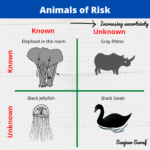A chemical facility is mandated to have an emergency response plan by OSHA PSM and EPA RMP. An accident in the plant, a hurricane, and a potential terrorist attack are a few scenarios that mandate emergency response and planning. However, there is a vast difference between having an emergency plan and having a plan that works.
Read the remainder of the article to find out if your facility’s emergency plan is an effective one.
Let us take a hypothetical example of an incident in a chemical plant that results in a release of a toxic cloud which is moving towards the community at 2 m/s. It is evident that your emergency plan should help protect people but is that the only consideration? What all factors should you consider as a part of your emergency plan?
I suggest thinking of an emergency plan implementation in three phases:
- Acute phase
- Post-incident phase
- Business interruption
Let us look at the factors you should consider for each the above phases.
Acute phase
The principal aim of the acute phase is to protect workers and community. But you also need to ask:
- Should all the workers be evacuated? Is there a recommended evacuation route?
- Should we initiate a shut-down?
- What should be the capacity of shelter-in-place?
- Should the community be evacuated? Can the community evacuate without causing traffic congestion?
- What should the media be told?
- Are any measures required for the livestock in the adjoining field?
Post-incident phase
A few considerations you may have to address after the incident:
- Will the release have a long-term impact on community or property?
- Are there any symptoms from the release that need to be monitored?
- Did the release impact community water supply?
- Is there a remediation technique that needs to be implemented at the community?
- Under what circumstances should you investigate remediation?
- What information can be disclosed to media and who has the authority to disclose?
Business interruption
Don’t forget your to take care of your customers.
- How to recover from the damage to the brand value?
- Should the manufacturing be stopped and if so, will you lose customers? Are there any backup suppliers?
- Will your efforts to contain legal exposure harm relations with customers, investors, regulators, and even employees?




4 Responses
The EPA’s RMP software is just so much BS! The model overpredicts many of the consequences and underpredicts others. If you have Chlorine in your facility, watch out! The EPA model originally published specified an incredibly large evacuation distance, something akin to 5 miles (8.5 km)diameter in the event of a 1 tonne release. As the regulation and the model were being published in their final draft, they were modified – without documentation and in contrast to what the development models implied.
The new RMP model recommends an evacuation distance of approximately 1.3 miles or 2.1 KM which is not justifiable by any of the EPA model studies.
The point is that RMP*comp may be good for something, but I’m not sure what. Certainly not for planning.
Thank you Dr.Saraf I’m passing on your email to the local LNG action group called Safe Haven.
Greetings from West Wales
Heather Sutton
Heather, you may want to donwload and get familiar with the Cameo Suite for the purposes of planning emergency response for incidents. it’s quite good.
Dave Russell
dlr@mindspring.com
Have I said how grateful I am, because I am very grateful for your quick response, indeed what we are struggling with is the official intransigence about safety, you have made it clear what we should be looking for.
I hope David will respond, he acts as the community policeman, which of course we should not need.
Greetings Heather